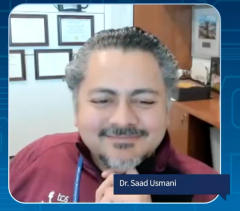
The Future of Multiple Myeloma Treatment is Bright and Promising
As a part of its Speaking Out Video series, CURE® spoke with Dr. Saad Usmani, on behalf of Throwing Bones for a Cure, about the future of multiple myeloma treatments.
Transcription: Colleen Moretti: What are some therapies in the pipeline that could make a significant difference in treating multiple myeloma?
Dr. Saad Usmani: We have come a long way in improving survival outcomes for myeloma patients over the past decade and a half and that's with better understanding of the disease process, the disease biology and developing therapies that can help patients. We now have better proteasome inhibitors … and what we call monoclonal antibodies, in the scheme of myeloma patients’ treatment.
What's coming down the pipe is new immunotherapies, where we can harness the power of the patient's immune system, T cells, NK cells. These are immune cells that can help us fight infections generally as well as we … abnormal or cancer cells. So we have what we call bispecific antibodies targeting different proteins on the surface of myeloma cells that are in clinical trials and in clinical development. One is already FDA approved, actually, a couple of months ago, Tecvayli (teclistamba), but there are about a dozen others that are coming down the pipeline and will be useful for our patients in the future.
We also have CARE T-cell therapies that we, we have two that are FDA approved right now, but there are several others that are trying to shorten the time period in which it takes to manufacture those CAR-T cell therapies for patients. We also have small molecules, cell mods as we call them, as well as BCL-2 inhibitor therapy treatments like Venclexta (venetoclax), that will be useful for certain subsets of myeloma patients. So, there's a lot of excitement about all these different treatments, and there are other small molecules that may be able to target specific types of myeloma as with certain gene mutations. So, all those efforts are very exciting and it's very promising future for our patients.
Moretti: What are some current gaps or unmet needs future therapies will have to fill?
Usmani: I think we need to figure out the right recipe for different kinds of patients, especially for our older myeloma patients. Out in the community right now, what we've been doing is modifying the regimens — reducing the dose and schedule for our patients. And now we're thinking alright, let's do this in a more systematic fashion and actually design clinical trials in which we can answer that question and really tailor treatment for the older patient population.
The other thing that we're trying to do more is to be more diverse in our clinical trial enrollment and include more minority patients, so that we can improve their outcomes for myeloma and also understand are there any specific nuances for certain drugs for different patient populations. And then in terms of the different other comorbidities like, kidney function, being too abnormal and studying certain high risk patient populations that are excluded from clinical trials like plasma cell leukemia and extramedullary myeloma etc. We can incorporate some of those patients in clinical trials and bridge those gaps in our knowledge.
Moretti: Is there a way patients can be a part of that change?
Usmani: Absolutely. I think it's very important for patients to ask their physicians, are there any clinical trial options available, and that they may be eligible for at the center where they're getting treatment. If the center doesn't have any treatment options in clinical trials, are there any other centers close by where they may partake in the clinical trial? All the advances we've made in myeloma is with this physician-patient partnership where patients have been able to get access to these newer treatments, to clinical trials and improve their outcomes. And then, as a result of those trials, those options get regulatory approval and become available to more patients. So, it's a closed loop circle when it comes to your patients reaping the benefit from the clinical trials, and then with the knowledge that begins, it helps future patients too.
Moretti: Where do you think, or hope, multiple myeloma treatment is going in the next five to 10 years?
Usmani: My hope is that we can come up with the right solutions for our standard risk, high risk older myeloma patients in the next five to 10 years. We are also able to define how long we need to treat our patients for and also potentially cure subsets of myeloma patients. And the future is bright. I think we can achieve that goal for patients. We need to continue to work hard and persevere.
This transcription has been edited for clarity.







